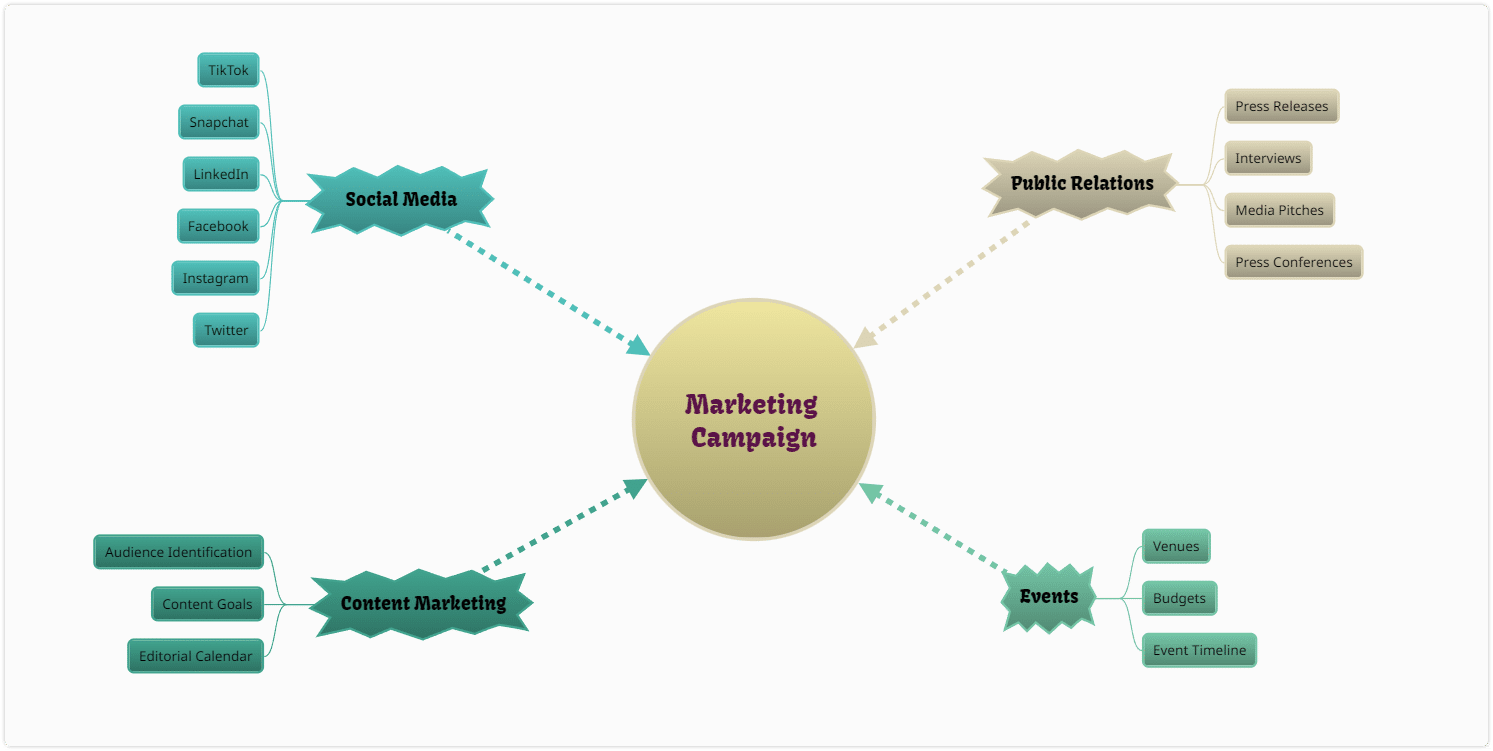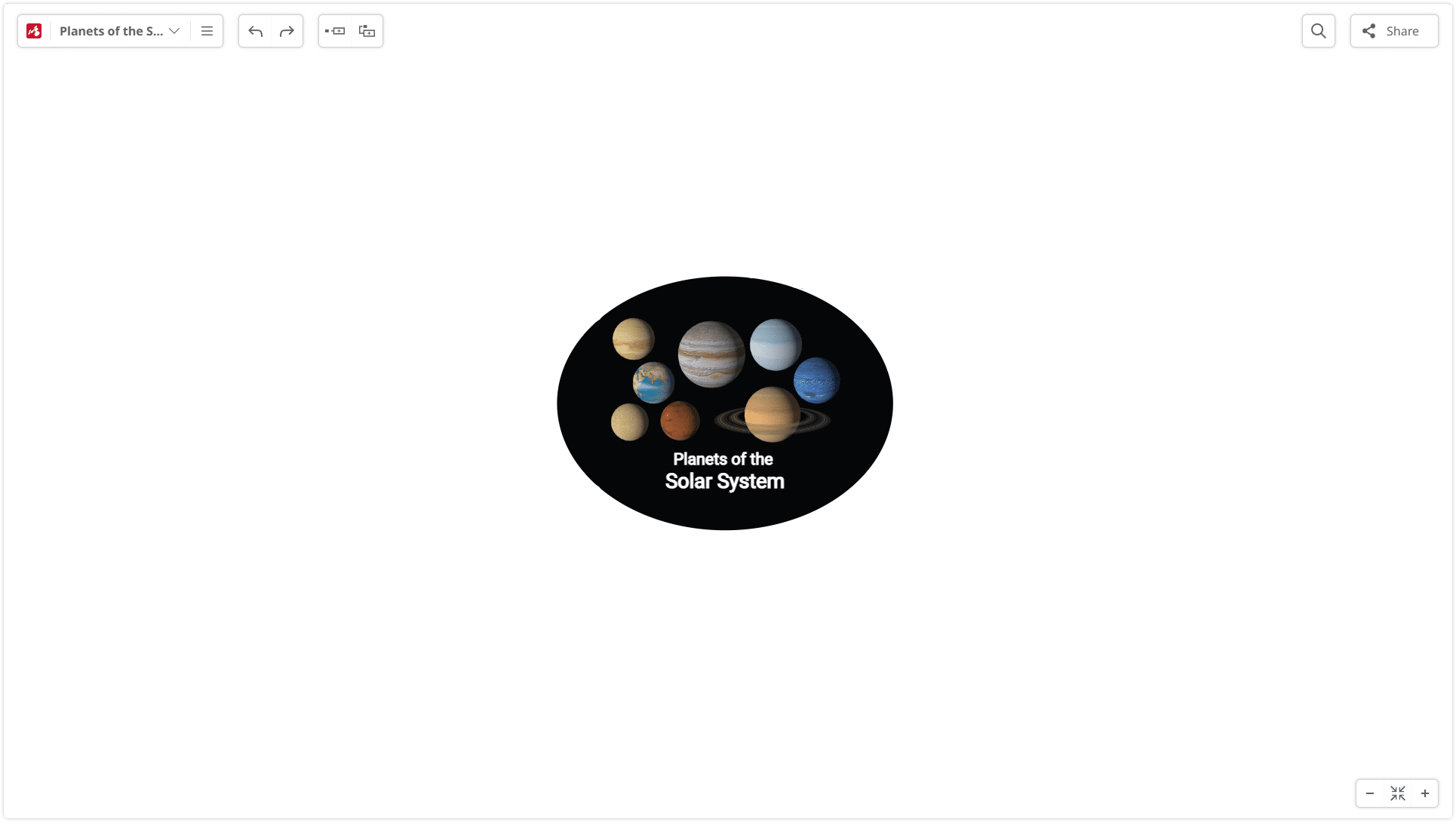
Mind maps. They’re your pathway to developing hundreds of ideas and solving complex problems. No matter what you’re up against.
Planning your next thriller novel? Sketch your plot on an idea map.
Prepping for a client presentation? Map it out.
Got a weekend DIY project? Create a plan with an idea map.
Trying to make sense of new software? Branch out its features on a mind map.
Mind maps are a roadmap for your thoughts. From storytelling to project planning, idea maps do the trick. Solutions? They’re just a branch away.
Let’s do a deep dive into what idea maps are and how they can help you get more done faster.
What is an idea map?
An idea map is your ally in creativity. It begins with a central idea. From there, branches stretch out. Each branch is a key concept related to your central idea. Lines link them, showing relationships. It’s a visual framework for your thoughts, aiding memory retention and concept exploration.
Whether you’re learning a new language, preparing a marketing strategy, or designing a website, mind maps help structure and visualize the task at hand.
That’s the magic of mind maps. Straightforward, yet effective.
But why use an idea map?
Idea generation, organization, and clarity – these are the cornerstones of idea maps. Envision being in the midst of project planning. It can be a maze. Here, mind mapping is your navigational aid. It presents a visual structure of your ideas, helping you see the bigger picture.
Idea generation is where mind mapping really shines. Brainstorming a new software feature? Start with a central idea and let your thoughts branch out. Each branch can trigger other ideas, encouraging creativity. The possibilities are never-ending when you’re working with an idea map.
Consider how mind maps could help you organize a marketing campaign. It can break down the plan into branches – social media, PR, content marketing, and events. Each branch can then sprout more specific tasks, targets, and deadlines.

As for how they can help with clarity, imagine you’re designing a new product. Mind maps can outline everything from user needs to manufacturing processes, linking related concepts. You see how ideas interconnect and flow, cutting through the confusion.
So, idea maps aren’t just scribbles on paper. They are organizational tools, clarity enhancers, and idea generators. They transform the abstract into the tangible, giving your thoughts a visual form. And that’s the power of mind mapping.
Mind mapping vs Brainstorming
So, what’s the difference between brainstorming and mind mapping? They’re two sides of the creative process coin.
Brainstorming

Brainstorming is the uninhibited sprint. The ground zero of ideas. During brainstorming sessions, it’s a shower of ideas flowing from different directions. The beauty of brainstorming? It’s raw and unrestricted. No idea is off-limits. It’s the initial spark, the ignition point of new ideas.
But brainstorming is not without its mess. Ideas often fly around, and finding connections can feel like untangling a yarn ball. That’s where mind mapping comes into play.
Mind Mapping

Creating a mind map is the deliberate walk. It takes the raw ideas from brainstorming and gives them a shape, a structure. Mind maps organize information visually, placing a central idea at the core. It’s like creating a spider diagram, linking the central idea to sub-ideas, like a tree with branches. Relationships between ideas become evident.
You start by creating a mind map with a key concept. From there, you build branches that represent related ideas. You can add images, colors, and even use sticky notes for additional details.
The advantage of mind mapping is the clear visual diagram it presents. It offers clarity and focus, giving you a bird’s eye view of your thoughts. It’s an effective way to retain information and explore new concepts.
Which one to choose?
But let’s not pit mind mapping vs brainstorming. They’re partners, collaborators. Brainstorming is the creative burst, the generator of different ideas. Mind mapping takes those ideas, organizes them, and visualizes the relationships between them. It’s like digging up creative gold from the brainstorming mine and refining it into something usable.
In a sense, mind maps are the next step after brainstorming. You can use Mindomo, an online mind map maker, to create these maps collaboratively in real time. Use it to generate ideas, plan projects, or solve complex problems. Then, share them. A collaborative mind with two is better than one.
Both methods serve the creative process. Whether you’re in a team or flying solo, use brainstorming to let ideas loose, then use mind mapping to give them a structure. Together, they provide a comprehensive approach to creative thinking and problem-solving.
How to create a mind map
Ready to dive into the mind mapping world? Here’s how…
1. Start with a Blank Page
First, write down your central idea. Place it in the center of the page. This is your ‘seed’ idea – the nucleus of your thought process. It could be anything – a project name, a concept you’re learning, a problem you’re solving, or a product you’re developing.
Remember, this central idea is the anchor of your map, the core from which all other ideas will radiate. So, make it count. Write it down in clear, concise words. You could even draw a symbol or image to represent it.

2. Grow Branches
Next, it’s time to grow the ‘branches’ from your seed idea. These are your key concepts. They stem directly from your central idea, providing the framework of your mind map.
How to do it? Recall Tony Buzan, the godfather of modern mind mapping. He suggests using single words or simple phrases for these branches. Keeping it concise helps maintain clarity and focus. It also leaves room for more ideas to flourish.
Each branch represents a separate aspect of your central idea. Working on a project plan? Branches could be tasks, team members, or deadlines. Writing a novel? They could be the plot, characters, setting, or theme.
Go on, stretch those branches out from the central idea. Use colors, symbols, images – whatever sparks joy and creativity.

3. Add Leaves
Here’s where things get interesting. Each branch of your idea tree is ready to sprout leaves. These leaves are the smaller, yet crucial, ideas linked to each branch. They are the granular details that make your idea map rich and comprehensive.
So, how does it work? Draw smaller lines off each branch. Each line represents an additional idea related to the key concept. Think of it as zooming in on each branch to explore more ideas.
Writing a business strategy? ‘Leaves’ could be the target audience, marketing channels, competitors for the ‘Marketing’ branch. Planning a vacation? They could be flight options, hotel choices, sightseeing spots for the ‘Travel’ branch.
Remember, this is where your creativity spreads its wings. Dive deep into each branch. Explore the nooks and crannies of your ideas. Your mind map is now more than a skeleton; it’s sprouting vibrant leaves of thoughts. It’s alive with details.

4. Add Some Flowers
Now, let’s add some ‘flowers’ to your idea tree. This is about color-coding and images, and it’s all about enhancing the visual appeal of your mind map.
Why colors? Research shows colors help our brain organize and remember information better. Assign a different color to each branch. Suddenly, your project timeline is green, the budget is blue, and the team tasks are yellow. It’s a color-coded journey through your thoughts.
And let’s not forget images. They are the eye-catching flowers on your idea tree. As the old saying goes, “A picture paints a thousand words.” Images can express ideas quickly and memorably. They boost memory, foster understanding, and let’s face it – they add a fun twist to your mind map!
Adding a new product feature? Why not add a doodle or an icon? Exploring marketing strategies? Insert logos of social media platforms. Be as creative as you like.
Your mind map is now in full bloom. Different colors guide your eye, images bring your ideas to life. From the central idea seed to a flourishing tree, your mind map is a visual feast of thoughts. A living, breathing testament to your brainstorming session.

5. Invite Others into the Garden
You’ve nurtured your idea map from a solitary seed to a full-fledged idea tree. It’s time to invite others into your creative garden. This is the step where collaborative idea cultivation begins.
Collaboration is a power-packed tool. It opens doors to new perspectives, fresh ideas, and constructive criticism. Invite your team members, classmates, or friends to join in. They bring their own creative flavors to the table, enhancing the richness of your mind map.
How does it work in practice? In project planning, team members can add their tasks and deadlines. In brainstorming for a new product, your team can suggest features, designs, and potential challenges. In academic research, your peers can contribute sources, arguments, and counterarguments.
But collaboration is more than just adding ideas. It’s about real-time interaction, feedback, and exploration. It’s about transforming your idea garden into a flourishing park of collective intelligence.
With Mindomo, inviting others into your mind mapping garden is a breeze. Real-time collaboration features mean you can co-create, discuss, and refine your mind map together, even if you’re miles apart.
So, open the gates of your idea garden. Let others in. Let them explore, add, prune, and grow with you. Your idea map is not just a tree anymore; it’s a thriving forest of collective creativity.
What are mind maps used for?
And the best part? Mindomo’s mind map uses are vast. Whether you’re tackling a world-changing project or structuring your research, this idea map is a brilliant tool to organize ideas and breathe life into new ideas.
Explore the world of mind maps with Mindomo today. Step away from the linear notes and start mapping your thoughts. From brainstorming sessions to final presentations, mind mapping adds a new layer of collaboration and creativity to your projects.
Idea maps take your creative ideas and present them in a visually striking way, making the process of generating and organizing ideas fun and effective. They’re more than just spider diagrams; they’re your creative compass, guiding you to discover more and create better.
With real-time collaboration and an infinite canvas, Mindomo is your ticket to this creative adventure. Ready to shape your ideas, inspire your team, and break new ground? Start creating with Mindomo today. It’s not just an idea map – it’s a whole new way of thinking.
Keep it smart, simple, and creative!
The Mindomo Team






